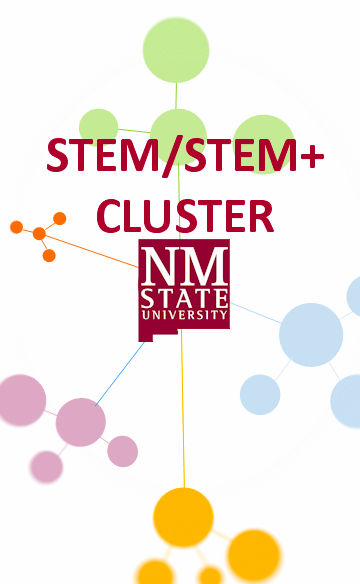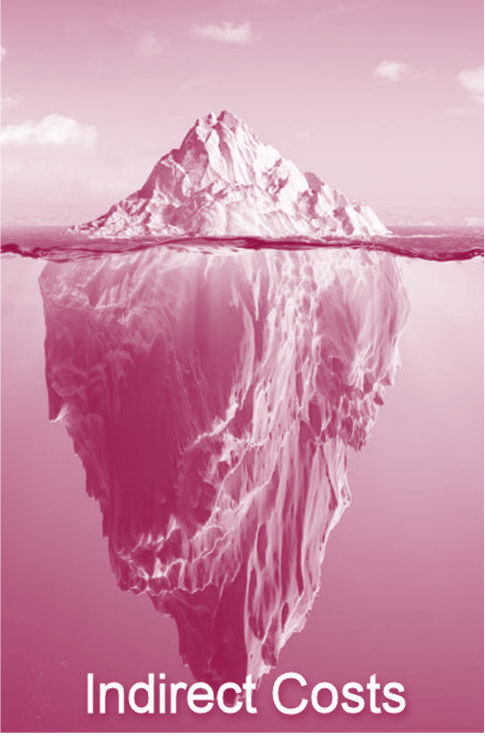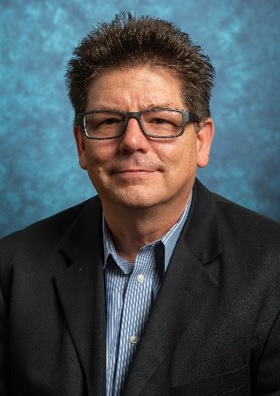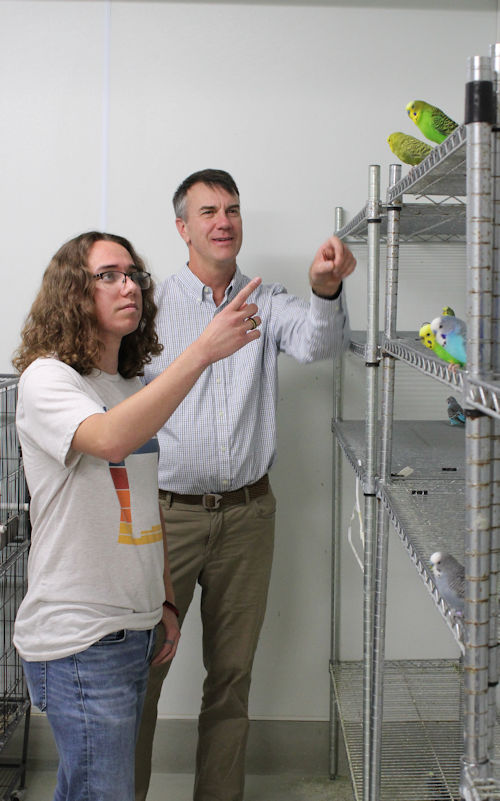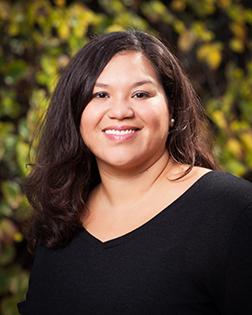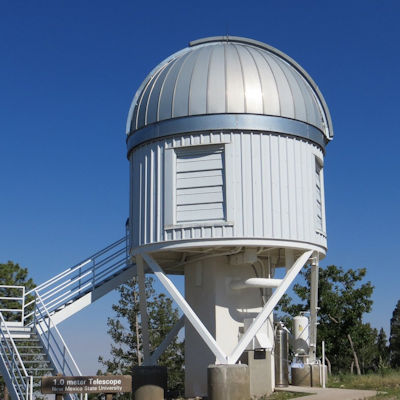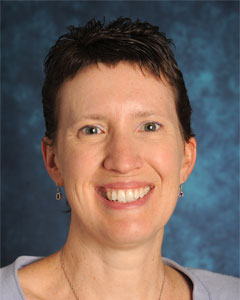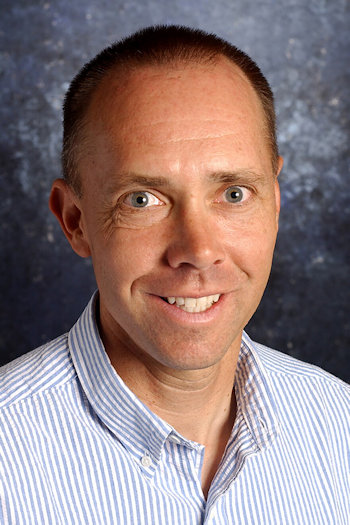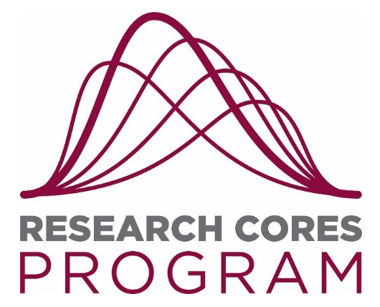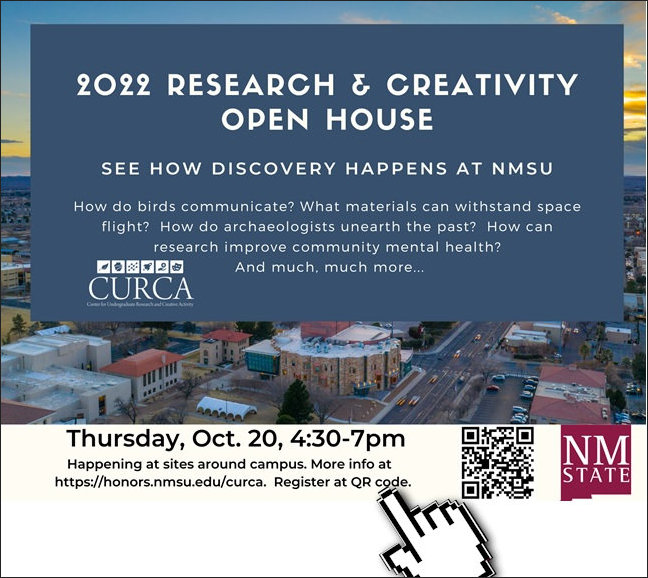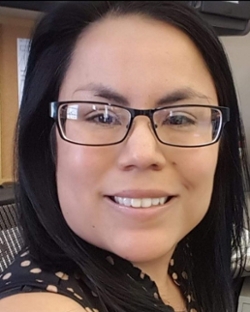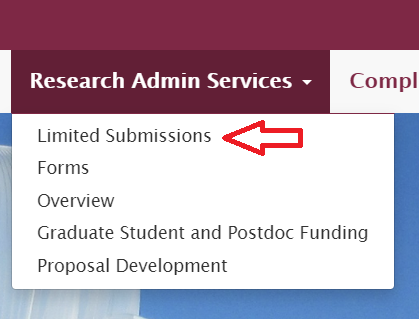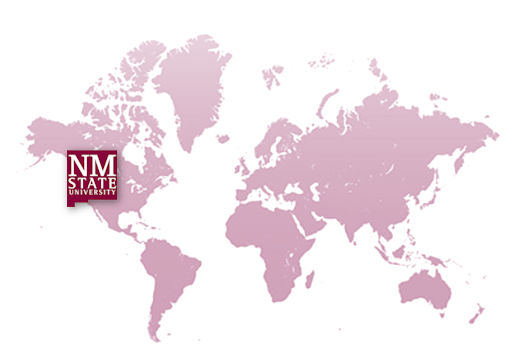 |
|
STEM/STEM+ Cluster Hire: Connecting the Dots
By Dr. Luis Cifuentes, Vice President for Research, Creativity, and Strategic Initiatives“You can't connect the dots looking forward; you can only connect them looking backwards. So you have to trust that the dots will somehow connect in your future.” Steve Jobs Four years ago, Chancellor Dan Arvizu included the imperative that NMSU address grand challenges with local implications in LEADS 2025. Among them, improving pre-K through university-level STEM education. NMSU teams have been highly active on this topic and I take this opportunity to provide updates on those activities. An ongoing effort, the Gadsden Math Initiative with the Gadsden Independent School District (GISD) was initiated over 17 years ago. Recently, the GISD Case Study has taken a reflective approach to assess a variety of curricular and co-curricular intervention strategies that have been implemented across the GISD system in collaboration with NMSU educators. The Case Study, led by Dr. Chris Engledowl in the College of HEST, involves a research team from various departments at NMSU and GISD, and will evaluate what worked, why it worked, and how can these Best Practices be scaled and replicated to enhance student learning and teacher professional development. Last May, over 20 NMSU faculty and staff gathered to brainstorm benefits and opportunities for creation of a university-level STEM education research center. Under the framing question “Imagine a STEM Education Center focused on research, outreach and the practice of STEM teaching and learning. What would it look like?” the group drafted a mission and vision, and mapped current assets. Consensus was to ensure inclusivity while elevating research on effective STEM teaching and learning among under-represented, rural and Tribal populations. A core working group has continued to formulate the proposed center since that time. This Fall, the department of Chemistry and Biochemistry, with the leadership of department head Dr. Shelley Lusetti and support of the dean, used an existing line to hire Dr. Paulette Vincent-Ruz after a competitive, national search. This was the first time in the history of the department that a tenure-track position was targeted for education research. Dr. Vincent-Ruz uniquely combines chemistry disciplinary knowledge and educational theory, which earned her the American Chemical Society's recognition as a Future Leader in Chemistry in 2019, the first time this was awarded to a chemistry education researcher. This hire is designed to improve chemistry education through Dr. Vincent-Ruz’s use-inspired research. As Albert Einstein wrote “[y]ou can’t solve a problem on the same level that it was created. You have to rise above it to the next level.” Armed with the Chancellor’s imperative to address the grand challenge of improving education in New Mexico, NMSU’s faculty-led efforts to create a STEM education research center, department of Chemistry and Biochemistry’s visionary hire, college of Arts and Sciences planned hire in Computer Science education, college of HEST’s need to replace an existing STEM education line in Teacher Preparation and Leadership (TPAL; Dr. Engledowl left NMSU last August) and the State endowing a line in TPAL, I proposed to the System Executive Budget Team the use of available, recurring strategic funds to add two new lines, and hire a cluster of faculty in STEM education research this Fall. The proposal was approved and NMSU, led by search committee chair, Dr. Michèle Shuster, is now advertising five hires in STEM/STEM+ education research. In late August, I met with Sandia National Laboratory (SNL) staff who participate in Quantum New Mexico. Upon mentioning the NMSU STEM/STEM+ cluster hire, I was connected with Dr. Megan Ivory, an experimental Atomic/Quantum Physicist in Photonic Microsystems Technology at SNL. Dr. Ivory’s current work at SNL includes developing and leading educational programs to teach quantum computing to high school and community college students and teachers. A few weeks ago, NMSU entered into its inaugural Individual Faculty Loan Agreement with SNL and Dr. Ivory has now joined the Klipsch School of Electrical and Computer Engineering. Deans in all colleges are encouraged to consider hires that can add to this growing community of education research and outreach scholars. How will the dots connect in the future? More to the point, will the cluster hire be successful, will the research center come together, will the faculty be retained? According to Cluster Hiring and Diversity, interdisciplinary cluster hires increase diversity, connectivity and innovate scholarship. Intentionally building community around faculty hires also has a positive impact on retention. I am quite hopeful. |
|
On Waiving IDC with Addendum
By Dr. Luis Cifuentes, Vice President for Research, Creativity, and Strategic InitiativesThe following article was originally published in July 2019, and was the first article I wrote for the Digest. I am reprinting it with an addendum (in italics) at the end. Often, I get asked to waive some or all indirect costs (IDC) budgeted in a grant submission. The reason for charging IDC, often times referred to as overhead, facilities and administrative costs, is to recover costs incurred in the performance of research that are not paid for directly (e.g., salaries and stipends of researchers and students, lab supplies and equipment, travel) by the grant or contract. The IDC rate at NMSU is negotiated with the federal government. Not all sponsors, Federal and otherwise, pay the full, negotiated IDC rate. For example, the Department of Education may have an IDC rate cap of 8%, significantly below the 49% on campus rate charged by NMSU. It is the policy of the Office of the Vice President for Research (now Research, Creativity and Strategic Initiatives) to allow submissions to sponsors who do not pay the full rate, including submissions to sponsors that do not pay any overhead. In order to meet the LEADS 2025 strategic plan goal of Elevating Research and Creativity, we need resources. Typically, moneys from the State, tuition and fees, endowment income and gifts, investment income, license fees, royalties and equity, and auxiliary units have limitations that do not allow for full investment in research. The best source of funds for research, scholarship, and creative activity is external sponsors who are able and willing to pay for full IDC. Every time, however, that NMSU accepts an external grant and contract that does not provide full IDC, we must use other funds to defray the cost of personnel (administrative, financial, maintenance, janitorial), compliance, safety, IT, utilities, library and research facilities and other. When principal investigators ask the VPR to waive IDC that a sponsor is willing and able to pay, they are asking him/her to approve use of internal resources to cover overhead costs. Internal resources that could be spent on faculty start-up, graduate student support, required cost-sharing on grants, instrument purchases and maintenance, seed grants and bridge funding. Every IDC dollar waived is a dollar not available for the strategic needs of NMSU’s research enterprise. Waiver of IDC was discussed recently at the Chancellor’s Executive Team (CET). I proposed, and CET unanimously supported my recommendation, that with rare exceptions, voluntary waiving of IDC is NOT allowed. Moreover, the rare exceptions will require CET approval. College deans and center/institute directors may, of course, choose to return their portion of the IDC to the grant or contract. College deans and center/institute directors may also ask the VPR (me) to contribute IDC back to the grant or contract. Requesting return of 100% of IDC (Central administration’s portion also), however, will also require CET approval. Please contact me if you need additional clarification. |
|
Meet Dr. Joe Tomaka, NMSU's New IRB Chair
By Ms. Michelle Gavin, Research Integrity Coordinator, RIC
Most of my research, especially early in my career, focused on issues related to stress and coping. In particular, I was interested in how cognitive appraisals of demanding situations could lead to differential stress responses, including emotional, behavioral, and physiological responses. Much of this research used an experimental approach that asked study volunteers—often college students—to appraise and respond to laboratory tasks designed to be stress-inducing (e.g., giving an impromptu speech). At the same time, we monitored their cardiovascular, affective, and behavioral reactions. |
Dr. Joe Tomaka, Professor of Public Health and NMSU's IRB Chair. |
NMSU Receives $7.2 Million NIH Award to Support NMSU's Lab Animal Vivarium
By Dr. Hamid Mansouri Rad, Senior Proposal Development Specialist, RASCongratulations to the NMSU team led by Dr. Tim Wright, Professor of Biology, who were successful in garnering a $7.2 million NIH C06 Facilities Construction award. This highly competitive funding will support construction of a new wild animal vivarium, aviary, and insectary on NMSU main campus. The building will complement a new lab animal vivarium already under construction supported by state bond funding that includes housing for lab animal models, behavioral and procedure rooms, diagnostic and analytical labs, a large surgery suite and support space. Construction will be guided by the NMSU team which includes members from the Office of Facilities and Services, the College of Arts and Sciences, the College of Agriculture, Consumer and Environmental Sciences, and VPR Luis Cifuentes. The combined complex, to be called the Biomedical Research Facility, will support NMSU’s biomedical research strengths in emerging infectious diseases, cancer and health disparities in underserved populations, enhance training of students from underrepresented populations, and promote research addressing the health of border communities and minority populations in New Mexico. |
|
NMSU Physical Science Laboratory Receives $2 Million DoD Funding
By Dr. Hamid Mansouri Rad, Senior Proposal Development Specialist, RASCongratulations to Dr. Marcella F. Shelby, Strategic Initiatives Officer at NMSU's Physical Science Laboratory (PSL), for leading an effort that led to garnering a $2 million from the Department of Defense. The funding will help PSL create a Defense Civilian Training Corps (DCTC) pilot program leveraging the already existing CREW program in the Lab. The DCTC serves as an accelerated recruitment and professional development program to increase diversity in the federal workforce. Similar to the CREW program, the DCTC program initiates application process for the graduates so they can obtain security clearance which is required for employment in the US national security fields. For more information, please contact Dr. Shelby at mshelby@psl.nmsu.edu. |
Dr. Marcella Shelby, NMSU/PSL |
NMSU Receives $1 Million NSF MRI Award
By Dr. Hamid Mansouri Rad, Senior Proposal Development Specialist, RASCongratulations to Dr. Jason Jackiewicz for his recent NSF award from the Major Research Instrumentation program. This competitive $1 million award supports Dr. Jackiewicz and his team's plans to acquire and assemble a telescope and spectrograph instrument to become part of a world-wide network dedicated to ‘listening’ to stars 24 hours per day. The facility will be located at NMSU's Apache Point Observatory. According to Dr. Jackiewicz, once completed the instrumentation will help establish the Stellar Observations Network Group (SONG) in New Mexico. This instrument will be an extremely valuable asset for NMSU undergraduate and graduate students, as well as the astronomy faculty. “It will be some of the most precise in the world for asteroseismology, and offers many research opportunities for decades,” he states. “SONG in New Mexico will be the only U.S. node of the network, enabling the NMSU as well as broader U.S. astronomy community to participate in important long-term observations of some of the most interesting stars in the sky.” |
|
Recognizing Large Proposal Submitters: October 2022
By Dr. Hamid Mansouri Rad, Senior Proposal Development Specialist, RASCongratulations to Drs. Michèle Shuster and Steve Stochaj for each submitting a proposal equal to greater than $1 million in amount requested. Dr. Michèle Shuster, NMSU Professor of Biology, submitted a $2.9 proposal to National Science Foundation in October. Titled NMSU-MÁS (Mejorando las Aulas en STEM/Improving STEM Classrooms), the proposed effort aims to enhance the retention and successful graduation of Hispanic, first-generation and low-income STEM students at NMSU by creating meaningful institutional intersections between teaching and learning, and equity, inclusion and diversity (EID). “We proposed to bring together campus leadership and experts on teaching and learning to work with faculty to emphasize active learning, connect course content to important personal and community values, and to use teaching practices that are welcoming to all STEM students,” states Dr. Shuster. Other members of the team include NMSU Chancellor Arvizu as the Institutional Director of the proposed program, Dr. Enrico Pontelli, Dean of the College of Arts and Sciences, as well as Drs. Louiza Fouli (Department of Mathematical Sciences) and Antonio Garcia (College of Engineering). For more information please contact Dr. Shuster at mshuster@nmsu.edu. Dr. Steve Stochaj, Head of the Department of Electrical and Computer Engineering, led a $1 million multi-institutional interdisciplinary proposal to the NSF Regional Innovation Engines program. This planning proposal aims at developing a regional innovation ecosystem focused on reducing carbon emissions in the operation of buildings, building construction, and the manufacturing of building materials. The effort involves collaboration between NMSU colleges of Engineering and Business, the Arrowhead Center, Dona Ana Community College, as well as the Energy Systems Laboratory at Texas A&M. Industry partners include National Renewable Energy Laboratory at Golden Colorado, the South-central Partnership for Energy Efficiency as a Resource (SPEER), HelioSourceTech, and GAF Energy. For more information, please contact Dr. Stochaj at sstchaj@nmsu.edu. |
|
2023-2024 Mountain-West CTR-IN Funding Opportunities: Limited SubmissionBy Dr. Hamid Mansouri Rad, Senior Proposal Development Specialist, RASThe Mountain-West CTR-IN program has released its 2023-2024 announcements for three types of funding: Pilot Project Grants (PPG), Multi-Site Pilot Project Grants (MSPP), and Community Engaged Research Pilot Grants (CERP). NMSU is one of the 12 universities that comprise the Mountain-West CTR-IN. The goal of these pilot grants is to enhance clinical and translational research capacity and increase extramural funding success among eligible applicants at member universities. Applying for these grants requires institutional nomination (by the Vice President for Research, Creativity, and Strategic Initiatives) by early December 2022. Invited proposals are due in March 2023. Because these are limited submission funding opportunities, eligible applicants must send email to ras@nmsu.edu as soon as possible, subject line: CTR-IN limited submission, mentioning the category they are interested in (PPG, MSPP, or CERP). We may nominate five applicants for PPG, one applicant for MSPP, and five applicants for MSPP proposals. Eligibility criteria includes having faculty appointment with at least 0.5 FTE and ability to commit at least 20% effort (2.4 person months) to the pilot project. For more information about the application process please contact me at hamid@nmsu.edu. |
|
Get to Know the Research Cores ProgramBy Dr. Tanner Schaub, Director, Research Cores ProgramTo better serve faculty researchers, Research Cores Program staff are meeting with departments and other research entities for brief program introductions this semester. Thus far, these have been ~15-minute presentations during department faculty meetings, but we are open to other formats. These introductions cover the basic structure of the Research Cores Program, strategies for leveraging RCP resources for your research and proposals, and input from directors of two of our larger our core laboratories: Drs. Samuel Belteton (microscopy) and Robert Young (chemical analysis/instrumentation). If you feel that the researchers in your unit would benefit from learning more about working with the RCP, please contact Dr. Tanner Schaub at tschaub@nmsu.edu. |
|
Postdocs Everywhere: Faculty Postdoc Mentors Sought for Professional Development ActivitiesBy Dr. Tanner Schaub, Director, Research Cores ProgramRCSI is now its third year of the Postdoctoral Matching Funds Program, which has partnered with faculty PIs, departments, and colleges to dramatically increase the number of postdoctoral researchers on campus. Our momentum is in full-swing, and NMSU is now home to 50 postdoctoral researchers. In addition to the RCSI program, we have seen some fantastic investments from the colleges, including >$500k in postdoc funding provided this year by Dr. Leslie Edgar through the ACES Agricultural Experiment Station. Our next task as an institution is to support our postdocs! To that end, RCSI has joined the National Postdoctoral Association (www.nationalpostdoc.org) and is formulating an institutional professional development program with activities for both postdocs as well as postdoc mentors. We would like to hear from faculty mentors that are willing to join us in the formation of this important new resource at NMSU. Interested faculty should contact Dr. Tanner Schaub at tschaub@nmsu.edu. In addition to professional development activity, RCSI is partnering with postdocs Dr. Matheus Cezarotto (ACES) and Dr. Maryanne Long (HEST) to create community. Drs. Long and Cezarotto have been hosting “Postdoc and New Faculty Meet Ups” – the next one is at Andale’s Dog House at 5pm on Thursday, October 27th. Please contact Christina at CKD@nmsu.edu for details. |
|
Cowboys for Cancer Research Applications Due October 30, 2022
By Ms. Cindy Ramirez, Proposal Development Specialist, RASNew Mexico State University announces the availability of a pilot project funding opportunity for NMSU faculty and staff through the Cowboys for Cancer Research organization in Las Cruces, NM. The purpose of this grant program is to encourage development of investigator-initiated research projects involving basic, preclinical, clinical, and translational cancer research, and acquisition of specialized instrumentation supporting collaborative cancer research. Please download the files here: Full Announcement, proposal Cover Page, and Budget Template. Applications are due on October 30, 2022. For any questions you can contact: Dr. Jeff Arterburn (jarterbu@nmsu.edu) for scientific/technical/budget queries and progress reports and Cindy Ramirez (cindyram@nmsu.edu) for administrative and submission queries. |
|
2022 Research and Creativity Open HouseBy Dr. Tracey Miller-Tomlinson, Associate Professor of English and Honors Faculty Fellow for the Center for Undergraduate Research and Creative Activity
On October 20, the Center for Undergraduate Research and Creative Activity hosts the second annual Research and Creativity Open House, happening at locations across the NMSU campus. Faculty and staff in a range of fields will welcome students into their labs, archives, galleries, and other spaces to see what discovery looks in their disciplines and learn how they can get involved. We are grateful to all of the following faculty, staff, and graduate students for hosting undergraduate visits: in Engineering, Abdu Abdelkefi, Meng Zhou, Veronica Gurrola, and Ken Ruble; in Health, Education, and Social Transformation, Christopher Aiken, Heike Lehnert-LeHouillier, Jagdish Khubchandani, Angela Owens; in Business, Yu-Feng Lee, Soyoung Jeon; in Agricultural, Consumer, and Environmental Sciences, Betsy Stringam; in Arts & Sciences, Meg Goehring, Marisa Sage, Jasmine Herrera, Courtney Uldrich, Tiffini Reiman, Aliya Cunningham, Storm Anderson, Kelly Jenks, Bill Walker, Mary Alice Scott, Teri Orr, Tim Wright and students, Paulette Vincent-Ruz, Dae Romero, Jaden Love, Aaron Lopez Gonzalez, Jeffrey Amato, Elinor Davis, Carlos Posadas, Michael Hout; and in the Library, Dennis Daily. For more information about the Center for Undergraduate Research and Creative Activity and to post opportunities for undergraduate students, please contact me at tomlin@nmsu.edu. |
|
NEH Selects NMSU Librarian to Serve on a Proposal Review Panel
By Dr. Hamid Mansouri Rad, Senior Proposal Development SpecialistCongratulations to Ms. Jennifer Olguin, Rio Grande Historical Collections Archivist at NMSU for having been invited to serve on an NEH Humanities Collections and Reference Resources proposal review panel. Ms. Olguin and two of her colleagues were recently awarded a $350,000 prestigious NEH award to digitize the 15,000-page correspondence from the Amador family. Ms. Olguin can be reached at jechavez@nmsu.edu. |
Ms. Jennifer Olguin, NMSU Library |
Limited Submission Funding OpportunitiesBy Dr. Hamid Mansouri Rad, Senior Proposal Development Specialist, RASResearch Administration Services maintains a list of limited submission funding opportunities for NMSU research community. The list is accessible through a link on the Research website, through the Research Administration tab. NMSU users can also access the list directly on SharePoint. We encourage NMSU researchers to periodically visit the site and if they are interested in any of the opportunities to please inform us by sending email to ras@nmsu.edu. |
|
Pivot Funding Opportunity DatabaseBy Dr. Hamid Mansouri Rad, Senior Proposal Development Specialist, RASThis is a reminder that in order to assist NMSU faculty and staff in locating external funding opportunities, the RCSI has purchased a subscription to ProQuest’s Pivot available at https://pivot.proquest.com/session/login.
To request a one-on-one or group Pivot training, send email to hamid@nmsu.edu. |
|
|
Graduate School |
|
Internal Employee Position for Foreign Credential EvaluationBy Dr. Carol Flinchbaugh, Interim Associate Dean for Graduate SchoolNMSU continues to receive growing numbers of graduate applications from international students. At times, the evaluation of the students’ foreign credentials can be difficult to interpret. For instance, transcript interpretation often involves verifying GPA on scales distinct from 4.0 scales and assuring students degrees are equivalent to a U.S. bachelor’s degree. Many U.S. universities are requiring graduate students to pay for third party vendors to conduct this evaluation. Yet this service can be cost prohibitive to many international students. After hearing from concerned faculty, the Provost’s Office and Graduate School agreed to hire an internal employee with experience and expertise in foreign credential evaluation. We hope to post this position within the next two weeks. We appreciate the collaborative communication efforts that helped move us to a decision that will help assure we enroll students who will be successful in their studies. |
|
Questions and comments regarding NMSU’s Research Digest should be directed to Hamid Mansouri Rad, Ph.D. at hamid@nmsu.edu, (575) 646-6429. |
|
